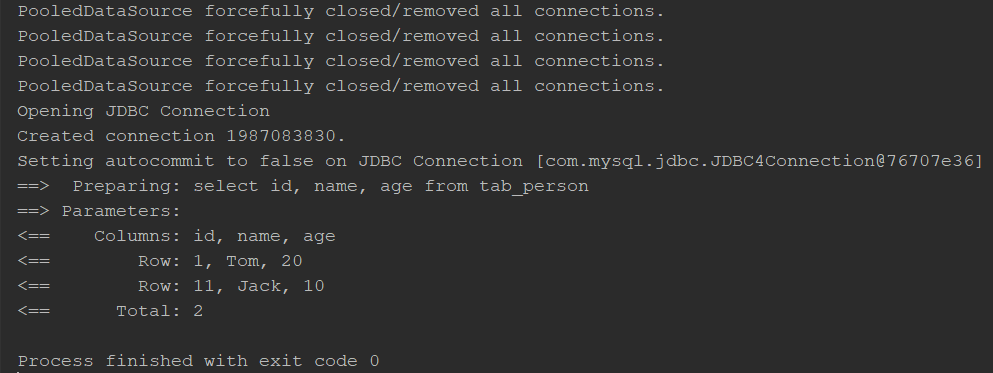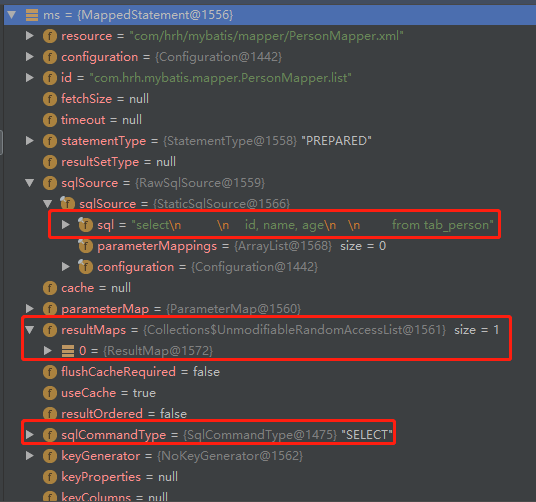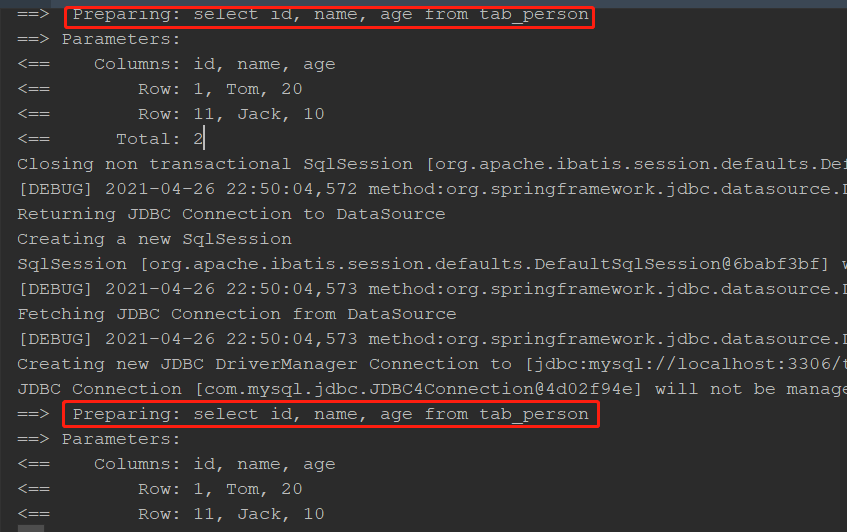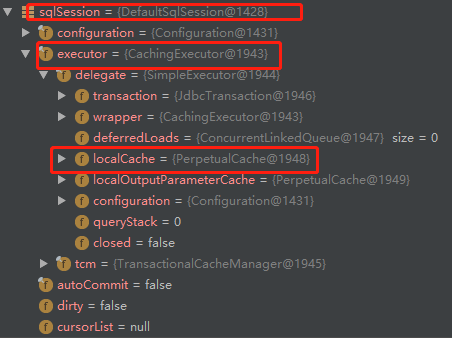1.在下面的案例中,执行两次查询控制台只会输出一次 SQL 查询:
mybatis-config.xml <?xml version="1.0" encoding="UTF-8" ?> <!DOCTYPE configuration PUBLIC "-//mybatis.org//DTD Config 3.0//EN" "http://mybatis.org/dtd/mybatis-3-config.dtd"> <configuration> <environments default="development"> <environment id="development"> <transactionManager type="JDBC"/> <dataSource type="POOLED"> <property name="driver" value="com.mysql.jdbc.Driver"/> <property name="url" value="jdbc:mysql://localhost:3306/xxx?useUnicode=true&characterEncoding=utf-8&autoReconnect=true"/> <property name="username" value="xxx"/> <property name="password" value="xxx"/> </dataSource> </environment> </environments> <mappers> <mapper resource="com/hrh/mapper/PersonMapper.xml"/> </mappers> </configuration>
PersonMapper.xml <?xml version="1.0" encoding="UTF-8" ?> <!DOCTYPE mapper PUBLIC "-//mybatis.org//DTD Mapper 3.0//EN" "http://mybatis.org/dtd/mybatis-3-mapper.dtd" > <mapper namespace="com.hrh.mapper.PersonMapper"> <resultMap id="BaseResultMap" type="com.hrh.bean.Person"> <id column="id" property="id" jdbcType="BIGINT"/> <result column="name" property="name" jdbcType="VARCHAR"/> <result column="age" property="age" jdbcType="BIGINT"/> </resultMap> <sql id="Base_Column_List"> id, name, age </sql> <select id="list" resultType="com.hrh.bean.Person"> select <include refid="Base_Column_List"/> from tab_person </select> </mapper>
public interface PersonMapper { List<Person> list(); }
String resource = "mybatis-config2.xml"; InputStream inputStream = Resources.getResourceAsStream(resource); SqlSessionFactory sqlSessionFactory = new SqlSessionFactoryBuilder().build(inputStream); SqlSession sqlSession = sqlSessionFactory.openSession();//开启会话 PersonMapper mapper = sqlSession.getMapper(PersonMapper.class); mapper.list(); mapper.list();

之所以会出现这种情况,是因为 Mybatis 存在一级缓存导致的,下面 debug 探究下内部流程:

(1)mapper.list() 会进入 MapperProxy#invoke():参数 proxy是一个代理对象(每个 Mapper 接口都会被转换成一个代理对象),里面包含会话 sqlSession、接口信息、方法信息;method 是目标方法(当前执行的方法),它里面包含了所属的哪个类(接口)、方法名、返回类型(List、Map、void 或其他)、参数类型等;args 是参数;
public Object invoke(Object proxy, Method method, Object[] args) throws Throwable { try { if (Object.class.equals(method.getDeclaringClass())) { return method.invoke(this, args); } else if (isDefaultMethod(method)) { return invokeDefaultMethod(proxy, method, args); } } catch (Throwable t) { throw ExceptionUtil.unwrapThrowable(t); } //从方法缓存methodCache中获取到方法的信息:比如方法名、类型(select、update等)、返回类型 //如果获取中没有MapperMethod,则创建一个并放入methodCache中 final MapperMethod mapperMethod = cachedMapperMethod(method); //执行查询SQL并返回结果 return mapperMethod.execute(sqlSession, args); }

cacheMapperMethod:MapperMethod 包含方法名、类型(select、update等)、返回类型等信息
private MapperMethod cachedMapperMethod(Method method) { //缓存中获取 MapperMethod mapperMethod = methodCache.get(method); //没有则创建一个对象并放入缓存中供下次方便取用 if (mapperMethod == null) { mapperMethod = new MapperMethod(mapperInterface, method, sqlSession.getConfiguration()); methodCache.put(method, mapperMethod); } return mapperMethod; }
(2)MapperMethod#execute() 根据 SQL 类型进入不同的查询方法
public Object execute(SqlSession sqlSession, Object[] args) { //返回结果 Object result; //判断语句类型 switch (command.getType()) { case INSERT: {//插入语句 Object param = method.convertArgsToSqlCommandParam(args); result = rowCountResult(sqlSession.insert(command.getName(), param)); break; } case UPDATE: {//更新语句 Object param = method.convertArgsToSqlCommandParam(args); result = rowCountResult(sqlSession.update(command.getName(), param)); break; } case DELETE: {//删除语句 Object param = method.convertArgsToSqlCommandParam(args); result = rowCountResult(sqlSession.delete(command.getName(), param)); break; } case SELECT://查询语句 //返回空的查询 if (method.returnsVoid() && method.hasResultHandler()) { executeWithResultHandler(sqlSession, args); result = null; //返回List的查询 } else if (method.returnsMany()) { result = executeForMany(sqlSession, args); //返回Map的查询 } else if (method.returnsMap()) { result = executeForMap(sqlSession, args); //返回游标的查询 } else if (method.returnsCursor()) { result = executeForCursor(sqlSession, args); } else { Object param = method.convertArgsToSqlCommandParam(args); result = sqlSession.selectOne(command.getName(), param); } break; case FLUSH: result = sqlSession.flushStatements(); break; default: throw new BindingException("Unknown execution method for: " + command.getName()); } if (result == null && method.getReturnType().isPrimitive() && !method.returnsVoid()) { throw new BindingException("Mapper method '" + command.getName() + " attempted to return null from a method with a primitive return type (" + method.getReturnType() + ")."); } return result; }
(3)上面的案例是 select 语句,返回结果是List集合,所以进入 MapperMethod#executeForMany():
private <E> Object executeForMany(SqlSession sqlSession, Object[] args) { List<E> result; //获取参数 Object param = method.convertArgsToSqlCommandParam(args); //是否有分页查询 if (method.hasRowBounds()) { RowBounds rowBounds = method.extractRowBounds(args); result = sqlSession.<E>selectList(command.getName(), param, rowBounds); } else { result = sqlSession.<E>selectList(command.getName(), param); } // issue #510 Collections & arrays support //如果list中的泛型跟结果类型不一致,进行转换 if (!method.getReturnType().isAssignableFrom(result.getClass())) { if (method.getReturnType().isArray()) { return convertToArray(result); } else { return convertToDeclaredCollection(sqlSession.getConfiguration(), result); } } return result; }
(4)selectList 执行了 DefaultSqlSession#selectList():
public <E> List<E> selectList(String statement, Object parameter) { return this.selectList(statement, parameter, RowBounds.DEFAULT); }
public <E> List<E> selectList(String statement, Object parameter, RowBounds rowBounds) { try { //SQL执行的信息:resource(xxMapper.xml)、id、sql、返回类型等 MappedStatement ms = configuration.getMappedStatement(statement); //执行查询 return executor.query(ms, wrapCollection(parameter), rowBounds, Executor.NO_RESULT_HANDLER); } catch (Exception e) { throw ExceptionFactory.wrapException("Error querying database. Cause: " + e, e); } finally { ErrorContext.instance().reset(); } }

(5)接下来调用缓存执行器的方法:CachingExecutor#query()
public <E> List<E> query(MappedStatement ms, Object parameterObject, RowBounds rowBounds, ResultHandler resultHandler) throws SQLException { //获取到执行SQL BoundSql boundSql = ms.getBoundSql(parameterObject); //将SQL包装成一个缓存对对象,该对象和结果集组成键值对存储到缓存中,方便下次直接从缓存中拿而不需要再次查询 //createCacheKey:调用BaseExecutor#createCacheKey CacheKey key = createCacheKey(ms, parameterObject, rowBounds, boundSql); return query(ms, parameterObject, rowBounds, resultHandler, key, boundSql); }
public <E> List<E> query(MappedStatement ms, Object parameterObject, RowBounds rowBounds, ResultHandler resultHandler, CacheKey key, BoundSql boundSql) throws SQLException { //获取缓存 Cache cache = ms.getCache(); if (cache != null) { flushCacheIfRequired(ms); if (ms.isUseCache() && resultHandler == null) { ensureNoOutParams(ms, boundSql); @SuppressWarnings("unchecked") List<E> list = (List<E>) tcm.getObject(cache, key); if (list == null) { list = delegate.<E> query(ms, parameterObject, rowBounds, resultHandler, key, boundSql); tcm.putObject(cache, key, list); // issue #578 and #116 } return list; } } //没有缓存连接查询 return delegate.<E> query(ms, parameterObject, rowBounds, resultHandler, key, boundSql); }
(6)接下来执行 BaseExecutor#query():从下面可以看到将结果缓存到 localCache 中了
public <E> List<E> query(MappedStatement ms, Object parameter, RowBounds rowBounds, ResultHandler resultHandler, CacheKey key, BoundSql boundSql) throws SQLException { ErrorContext.instance().resource(ms.getResource()).activity("executing a query").object(ms.getId()); if (closed) { throw new ExecutorException("Executor was closed."); } //如果不是嵌套查询(默认为0),且 <select> 的 flushCache=true 时清空缓存 if (queryStack == 0 && ms.isFlushCacheRequired()) { clearLocalCache(); } List<E> list; try { //嵌套查询层数+1 queryStack++; //从localCache缓存中获取 list = resultHandler == null ? (List<E>) localCache.getObject(key) : null; if (list != null) { handleLocallyCachedOutputParameters(ms, key, parameter, boundSql); } else { //连接查询 list = queryFromDatabase(ms, parameter, rowBounds, resultHandler, key, boundSql); } } finally { queryStack--; } //下面是延迟加载逻辑 if (queryStack == 0) { for (DeferredLoad deferredLoad : deferredLoads) { deferredLoad.load(); } // issue #601 deferredLoads.clear(); if (configuration.getLocalCacheScope() == LocalCacheScope.STATEMENT) { // issue #482 clearLocalCache(); } } return list; }
private <E> List<E> queryFromDatabase(MappedStatement ms, Object parameter, RowBounds rowBounds, ResultHandler resultHandler, CacheKey key, BoundSql boundSql) throws SQLException { List<E> list; //缓存中添加占位符 localCache.putObject(key, EXECUTION_PLACEHOLDER); try { //连接查询获取到数据结果 list = doQuery(ms, parameter, rowBounds, resultHandler, boundSql); } finally { //删除占位符 localCache.removeObject(key); } //将结果缓存起来 localCache.putObject(key, list); //处理存储过程 if (ms.getStatementType() == StatementType.CALLABLE) { localOutputParameterCache.putObject(key, parameter); } return list; }
2.但当 Spring Framework + Mybatis 时,情况就不一样了,每次查询都会连接数据库查询,控制台都会打印 SQL 出来,如下案例:
@Service public class PersonService { @Autowired PersonMapper personMapper; public List<Person> getList() { personMapper.list(); personMapper.list(); return personMapper.list(); } }
@Configuration @ComponentScan("com.hrh") @MapperScan("com.hrh.mapper") public class MyBatisConfig { @Bean public SqlSessionFactoryBean sqlSessionFactory() throws Exception { SqlSessionFactoryBean factoryBean = new SqlSessionFactoryBean(); factoryBean.setDataSource(dataSource()); factoryBean.setMapperLocations(resolveMapperLocations()); return factoryBean; } public Resource[] resolveMapperLocations() { ResourcePatternResolver resourceResolver = new PathMatchingResourcePatternResolver(); List<String> mapperLocations = new ArrayList<>(); mapperLocations.add("classpath*:com/hrh/mapper/*Mapper*.xml"); List<Resource> resources = new ArrayList(); if (mapperLocations != null) { for (String mapperLocation : mapperLocations) { try { Resource[] mappers = resourceResolver.getResources(mapperLocation); resources.addAll(Arrays.asList(mappers)); } catch (IOException e) { // ignore } } } return resources.toArray(new Resource[resources.size()]); } @Bean public DataSource dataSource() { DriverManagerDataSource driverManagerDataSource = new DriverManagerDataSource(); driverManagerDataSource.setDriverClassName("com.mysql.jdbc.Driver"); driverManagerDataSource.setUsername("xxx"); driverManagerDataSource.setPassword("xxx"); driverManagerDataSource.setUrl("jdbc:mysql://localhost:3306/xxx?useUnicode=true&characterEncoding=utf-8&autoReconnect=true"); return driverManagerDataSource; } }
AnnotationConfigApplicationContext context = new AnnotationConfigApplicationContext(MyBatisConfig.class); PersonService bean = context.getBean(PersonService.class); bean.getList();

下面debug进入的步骤跟上面的(1)、(2)、(3)是一致的,但第四步却是进入 SqlSessionTemplate#selectList() 中【SqlSessionTemplate是mybatis-spring-xx.jar的,上文的DefaultSqlSession是属于mybatis-xx.jar的】:
public <E> List<E> selectList(String statement, Object parameter) { return this.selectList(statement, parameter, RowBounds.DEFAULT); }
接下来的 selectList() 会被方法拦截:method.invoke() 会执行到 DefaultSqlSession#selectList(),重新回到上文的第四步并且继续下去,也就是在上文的(1)~(6)中插入了前后文,在其中做了关闭会话的操作;
private class SqlSessionInterceptor implements InvocationHandler { @Override public Object invoke(Object proxy, Method method, Object[] args) throws Throwable { //得到会话 SqlSession sqlSession = getSqlSession( SqlSessionTemplate.this.sqlSessionFactory, SqlSessionTemplate.this.executorType, SqlSessionTemplate.this.exceptionTranslator); try { //执行方法查询 Object result = method.invoke(sqlSession, args); if (!isSqlSessionTransactional(sqlSession, SqlSessionTemplate.this.sqlSessionFactory)) { // force commit even on non-dirty sessions because some databases require // a commit/rollback before calling close() sqlSession.commit(true);//在关闭会话前提交和回滚 } return result; } catch (Throwable t) {//有异常抛出异常并结束会话 Throwable unwrapped = unwrapThrowable(t); if (SqlSessionTemplate.this.exceptionTranslator != null && unwrapped instanceof PersistenceException) { // release the connection to avoid a deadlock if the translator is no loaded. See issue #22 closeSqlSession(sqlSession, SqlSessionTemplate.this.sqlSessionFactory); sqlSession = null; Throwable translated = SqlSessionTemplate.this.exceptionTranslator.translateExceptionIfPossible((PersistenceException) unwrapped); if (translated != null) { unwrapped = translated; } } throw unwrapped; } finally { //关闭会话 if (sqlSession != null) { closeSqlSession(sqlSession, SqlSessionTemplate.this.sqlSessionFactory); } } } }

总结:
Mybatis 的一级缓存是会话级别的缓存(单线程的,特别鸡肋),Mybatis 每创建一个 SqlSession 会话对象,就表示打开一次数据库会话,在一次会话中,应用程序很可能在短时间内反复执行相同的查询语句,如果不对数据进行缓存,则每查询一次就要执行一次数据库查询,这就造成数据库资源的浪费。又因为通过 SqlSession 执行的操作,实际上由 Executor 来完成数据库操作的,所以在 Executor 中会建立一个简单的缓存,即一级缓存;将每次的查询结果缓存起来,再次执行查询的时候,会先查询一级缓存(默认开启的),如果命中,则直接返回,否则再去查询数据库并放入缓存中。

一级缓存的生命周期与 SqlSession 的生命周期相同,因此当 Mybatis 和 Spring Framework 的集成包中扩展了一个 SqlSessionTemplate 类(它是一个代理类,增强了查询方法),所有的查询经过 SqlSessionTemplate 代理拦截后再进入到 DefaultSqlSession#selectList() 中,结束查询后把会话SqlSession 关了,所以导致了缓存失效。
那为什么要这么操作呢?
原始的 Mybatis 有暴露 SqlSession 接口,因此有 close 方法暴露出来供你选择使用,你可以选择关与不关,但在 Mybatis 和 Spring Framework 的集成包中,SqlSession 是交给了 Spring Framework 管理的,没有暴露出来,为了稳妥决定,直接给你关了。